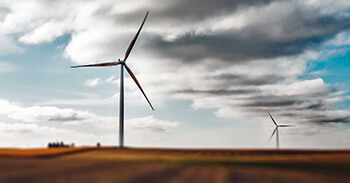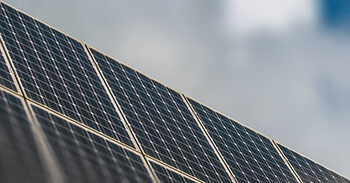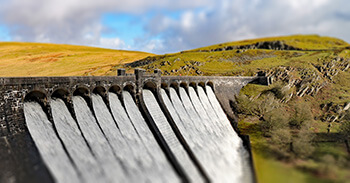How green? UK renewable energy providers' fuel mix ranked

Energy providers come in all shapes and sizes but one thing that all renewable energy companies have in common is their claim to only use green energy resources. We closely examine fuel mix disclosures, so you don’t have to, and we rank self-professed renewable energy suppliers on how green they really are.
Where does renewable electricity come from?
UK renewable electricity comes primarily from solar panels, wind turbines, hydroelectric run-of-the-river plants and larger dams. These facilities are designed to capture clean energy from the sun, wind, moving water or geothermal sources and convert it to electricity that can be used in homes and businesses nationwide.
Electricity sourced from renewable generators is fed into the national grid, for the most part. There are no special cables to separate green energy from the rest. Since energy suppliers buy electricity wholesale to then sell onto their customers, they can choose to only buy from green power generators. To streamline the process OFGEM issues Renewable Energy Guarantees of Origin (REGO) that certify that electricity bought by suppliers is truly green.
While renewable sources of electricity are subject to weather patterns, they have one distinct advantage over nuclear, coal and gas. Unlike fossil or nuclear fuels, renewable energy sources will never run out. Meanwhile, the availability of finite fuels will dwindle which inevitably will make them more expensive. This means that renewable electric power represents sustainable development as well as being a cost-effective choice for today and tomorrow.
Environmental impact of green energy
All human activity carries an environmental impact and this includes generating electricity, whether you are doing so through conventional or renewable means. Gas, coal and nuclear power stations affect air quality, generate greenhouse gases or dangerous waste that is difficult to store safely.

The negative impact of nonrenewable fuels on our planet cannot be ignored. Climate change, pollution and radioactive waste have a real cost that is not just environmental or human but also economic. Pollution-related health problems and dangerous waste disposal or clean up may not be immediately linked to the energy sector but that doesn’t stop them from adding up to the liabilities of relying on fossil fuels for utility scale power plants.
To say that renewable energy is the silver bullet would be disingenuous. However, the difference is night and day when it comes to long lasting and costly concerns like having to deal with radioactive or chemical power plant waste. Renewable sources of electricity are vastly more sustainable than its fossil and finite fuel generated equivalents.
Let’s have a look at the environmental impact of renewable forms of energy and how they can be managed.
1. The impact of wind power
The good news about wind power turbines is that there are no global warming emissions related to their operation. However, when it comes to the manufacture, transport and installation of wind turbines, global warming carbon emissions are currently unavoidable. However, carbon emissions related to wind energy are anywhere between 96% to 98.8% less than those from gas or coal power plants.

In terms of impact on wildlife and land use, there are legitimate concerns to be had. Land-based wind energy generation can use as much as 141 acres per megawatt produced. On the other hand, wind turbines only permanently occupy one acre of land, meaning that the rest can be used for other purposes. While wind turbines can cause bird and bat deaths, mainly due to collisions, these are minimal and do not pose an existential threat to natural diversity. Nevertheless, natural conservation agencies and wind farm operators have taken it upon themselves to modify designs and operating procedures to reduce the impact on flying species.
Offshore wind turbines paint a much rosier picture even though their impact on marine birds, shipping routes and fishing areas must be taken into account. Some studies actually point to increases in fish populations around off-shore wind farms because they provide sanctuary to many marine species by taking on the role of artificial reefs.
| Carbon emissions by kWh produced | Wind power | Gas and coal power |
|---|---|---|
| Minimum lifecycle emissions per kWh | 0.02 lbs of carbon | 0.6 lbs of carbon |
| Maximum lifecycle emissions per kWh | 0.06 lbs of carbon | 3.6 lbs of carbon |
Source: Environmental Impacts of Wind Power, Union of Concerned Scientists, 2013
2. The impact of solar energy
Again, you can rest easy knowing that capturing energy from the sun, either through photovoltaic (solar PV) or water-heating solar panels, does not produce the harmful greenhouse gas emissions associated with fossil fuels. There are however some legitimate issues relating to large scale solar panel installations that cannot be ignored.
Depending on the location of solar panel installations, land use and wildlife habitat loss can be causes for concern. Especially since solar panels permanently occupy larger swathes of land than wind turbines. However, it is worth noting that solar panel facilities can be placed in a wider range of locations than wind farms, meaning that impinging on farm land can be largely avoided.

When it comes to manufacturing and installing solar panels, you are still going to find some global warming emissions that are partially amortised over the life of the solar panels. However, it is worth noting that photovoltaic panel manufacturing uses most of the same hazardous chemicals as electronic component manufacturing in order to treat semiconductor parts. These include hydrochloric, nitric, sufuric acids, hydrogen fluoride and trichloroethane.
The good news is that a lot of newer solar panel components are made with rare earth metals such as gallium arsenide and cadmium telluride which can easily be recycled and re-used since they command high unit prices.
In terms of carbon emissions over their effective lifetimes, solar technology ranks above wind energy while still maintaining a fraction of the environmental impact of coal and gas.
| Carbon emissions by kWh produced | Solar energy | Gas and coal energy |
|---|---|---|
| Minimum lifecycle emissions per kWh | 0.07 lbs of carbon | 0.6 lbs of carbon |
| Maximum lifecycle emissions per kWh | 0.18 lbs of carbon | 3.6 lbs of carbon |
IPCC, 2011: IPCC Special Report on Renewable Energy Sources and Climate Change Mitigation
3. The impact of biomass electricity
The crux of determining the environmental impact of biomass use in electricity generation depends less on the production process and more on the source of the raw material. Since biomass uses the gases released as organic material decomposes, environmental impact varies according to the kind of organic material used.

Here are some possible sources and examples:
- Agricultural waste: manure and spoilt crops
- Algae
- Energy crops grown specifically for biomass processing
- Forestry and urban residue
Using waste products to produce energy might seem like a dirty method of making energy, however the opposite is true. Since this organic waste would be produced regardless, getting energy out of it is actually more environmentally friendly than letting it sit in a landfill or other waste disposal facility.
For the UK specifically, all sources of organic waste are equally valid as a means of generating biogas, except for energy crops. This is because there is limited availability of arable land and devoting land to energy crops like switchgrass means having less land to grow food.
4. The impact of hydroelectric energy
The environmental impact of hydroelectric dams and run-of-the-river plants varies greatly by location. On the one hand, you have large dams that have flooded thousands of square miles of terrain, and then you have smaller plants that are part of an existing river or exploit deep canyons that are just as effective with a much smaller footprint.
The overriding concerns when it comes to hydroelectric energy is the displacement of not just wildlife but also human communities that can find themselves uprooted by colossal hydroelectric projects. While fish ladders and inlet screens help to reduce habitat impact for water-based species, the fact that dam water tends to be more stagnant also needs to be addressed. In largely static water, a buildup of sediments and detritus can lead to an explosion of algae and aquatic weeds, especially if the weather is warm.

Issues such as these requires the dam operators to take active measures such as harvesting or using fish species that keep algae under control.
Aside from habitat and human impacts, hydropower has the widest range of lifetime carbon emissions per unit of electricity generated. At its most sustainable, for small run-of-the river-type plants, it outperforms wind energy. When it is least sustainable, for dams located in areas rich with organic matter such as tropical areas and peatlands, its kilowatt hours rated lifetime carbon emissions rival those of gas-fired power stations.
| Carbon emissions by kWh produced | Hydro power | Gas and coal power |
|---|---|---|
| Minimum lifecycle emissions per kWh | 0.01 lbs of carbon | 0.6 lbs of carbon |
| Maximum lifecycle emissions per kWh | 0.5 lbs of carbon | 3.6 lbs of carbon |
Source: National Academy of Sciences. 2010. Electricity from Renewable Resources: Status, Prospects, and Impediments.
Top green UK providers ranked
Bear in mind that no matter what kind of renewable source of electricity a green energy supplier relies on, they are making the UK a better place. Renewable energy wins out in terms of sustainability, the environment and also increasing energy self-reliance while lowering energy costs for UK consumers.
To put it bluntly, coal, gas and nuclear cannot hold a candle to renewable energy. In this day and age, there are no good reasons for electricity suppliers to still rely on fossil fuels and nuclear energy.
Below you can find our ranking of renewable electricity suppliers in the UK based on the relative environmental impact of each form of renewable generation. We have also broken down where their renewable electricity comes from so you can make an informed decision.
Regardless of which electric provider you go with, you will be making a net positive impact on the environment.
| Supplier | Wind | Solar | Biomass | Water |
|---|---|---|---|---|
| 99.18% | 0.12% | 0% | 0.7% | |
| 68% | 32% | 0% | 0% | |
| 57% | 18% | 20% | 5% | |
| 52% | 48% | 0% | 0% | |
| 51% | 40% | 0% | 9% | |
| 44.81% | 29.41% | 6.9% | 18.88% | |
| 34% | 3% | 50% | 13% | |
| 18% | 32% | 49% | 1% | |
| 10.67% | 45.61% | 43.28% | 0.44 % |
UK energy mix and the national grid

Having electricity companies that source renewable energy is only part of the energy puzzle for the UK. To truly leverage the opportunities of renewables, private and public sectors need to work together to make our electricity grid smarter so it can more easily respond to changes in supply and demand.
The smart meter rollout is the initial step towards a future where renewable energy sources can be load-balanced with distributed generation alongside battery or gas stored electricity to ride the peaks and troughs of the energy market. There is no one-size-fits-all solution but the real time data that smart meters provide will partly answer what our energy future looks like.
This article has focused on renewable electricity because all green gas is sourced from biomass exclusively. Additionally, green or biogas production is still fairly limited when compared to renewable electricity. The future of natural gas for residential customers is looking increasingly dire with the government looking to curtail its use after 2025.
